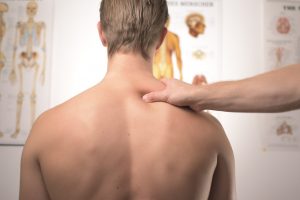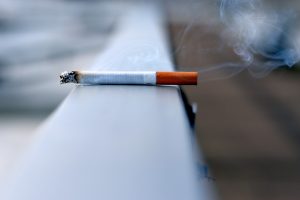

Bones consist of living tissue that continuously deteriorates and rebuilds itself. Under a microscope, this young, healthy bone structure is dense and resembles a honeycomb. However, as you age, your bones tend to break down faster than your body can rebuild them. If you lose too much bone or make too little, they may develop holes in them and become porous.
Because they are less dense, osteoporotic bones are weaker and more likely to break. Even a cough or sneeze could cause a fracture during the later stages of osteoporosis.
Treating this disease in its earliest stages is one of the best ways to prevent fractures and breaks. Learning about the symptoms and risk factors can also help you avoid serious injury and keep your bones healthy and strong.
Risk Factors
While anyone can develop osteoporosis, certain risk factors may make you more likely to lose bone density and suffer injuries from this disease.
1. Age
During childhood and adolescence, your body continues to deposit much more bone than it takes away. In fact, your bones gain up to 90% of their mass by ages 18 for women and 20 for men. Bone density will peak around age 30, at which point you may begin to experience minor bone loss. However, those over the age of 50 are at the greatest risk for osteoporosis and subsequent complications.
2. Gender and Hormones
Osteoporosis is also more common in people who have abnormal hormone levels. For instance, low levels of estrogen in women — especially during menopause — and low testosterone in men are among the strongest risk factors for developing this bone disease. Overactive thyroid, parathyroid and adrenal glands can also cause bone loss. Consequently, one in every three women will develop osteoporosis as opposed to only one in five men.
3. Family and Medical History
If your parents or grandparents have osteoporosis or have broken or fractured a hip, you may be more likely to get osteoporosis, too. Health problems that may or may not run in your family may also increase your risk. For instance, breast cancer, sickle cell disease, diabetes and even depression can cause bone loss. Additionally, medicines like heparin and steroids like cortisone and prednisone can cause bone loss if you take a high dose for long periods.
4. Physical Build
Men and women with small, petite frames also tend to have a higher risk because they have less bone mass to draw from as they age. However, those who are overweight or obese may also be in danger of developing osteoporosis. This risk increases even more as their weight puts more pressure on their weakening bones.
5. Lifestyle Choices

The risk factors above are unchangeable. However, other factors like whether you smoke or drink alcohol are up to you and may very well influence your likelihood of developing osteoporosis. A sedentary lifestyle and general lack of weight-bearing exercise also increase your risk. Low calcium, vitamin D and protein intake won’t do your bones any favors, either, so be sure to care for your body, especially as you age.
Symptoms
Osteoporosis has a way of sneaking up on you. Since most people don’t notice or experience symptoms during the early stages, they often don’t know they have weak bones until they break or fracture one. Therefore, learning to recognize the following signs may help you detect and treat the disease early on.
1. Brittle Fingernails
How strong or brittle your nails are can clue you in to how healthy your bones are. For instance, if your nails break easily, you may be experiencing hormonal fluctuations or a vitamin deficiency. Likewise, if your nails are healthy, they likely have high calcium and magnesium concentrations, signaling healthy bones.
2. Receding Gums
Bone loss has a direct link to oral and dental health. If you’re losing bone mass in your jaw or teeth, your gums may begin to recede. This symptom often signals bone loss in other parts of your body. Postmenopausal women are especially likely to experience tooth and bone loss due to hormone changes.
3. Neck and Back Pain
A sudden onset of back or neck pain may also be cause for worry and a chat with your doctor. An increase in pain when standing or walking and lack of spinal mobility often point to osteoporosis or spinal fractures due to the disease. Cramps and aches in your neck and back might also signal vitamin D and magnesium deficiencies.
4. Poor Posture
It’s natural to lose some height as you age. However, a curved spine or hump at the base of the neck isn’t normal and can cause poor posture, making you look shorter than you are. These symptoms can also clue you into a possible osteoporosis diagnosis. Kyphosis, or dowager’s hump, can also lead to more serious symptoms like crumbling vertebrae and sharp pain.
5. Bone Fractures
Compression fractures may also shorten the spinal column, cause pain and signal bone loss. Typically, fractures and breaks happen after you’ve been experiencing bone loss for some time. However, it may also be the first sign of osteoporosis and alert you and your doctor of your condition.
Treating and Preventing Osteoporosis
The best way to treat osteoporosis is to prevent the disease from occuring altogether. If you have genetic and physical predispositions to experiencing bone loss, an eventual diagnosis may be unavoidable. However, there are many ways to postpone it and build strong bones so you can live a long, happy life.
Good nutrition and exercise are essential for maintaining and improving bone health. By increasing your protein, calcium and vitamin D intake and engaging in weight-bearing activity, you can effectively build stronger bones. If you still develop osteoporosis later in life, your doctor can prescribe medication to balance your hormones, manage pain and rebuild bone mass.


Be the first to comment